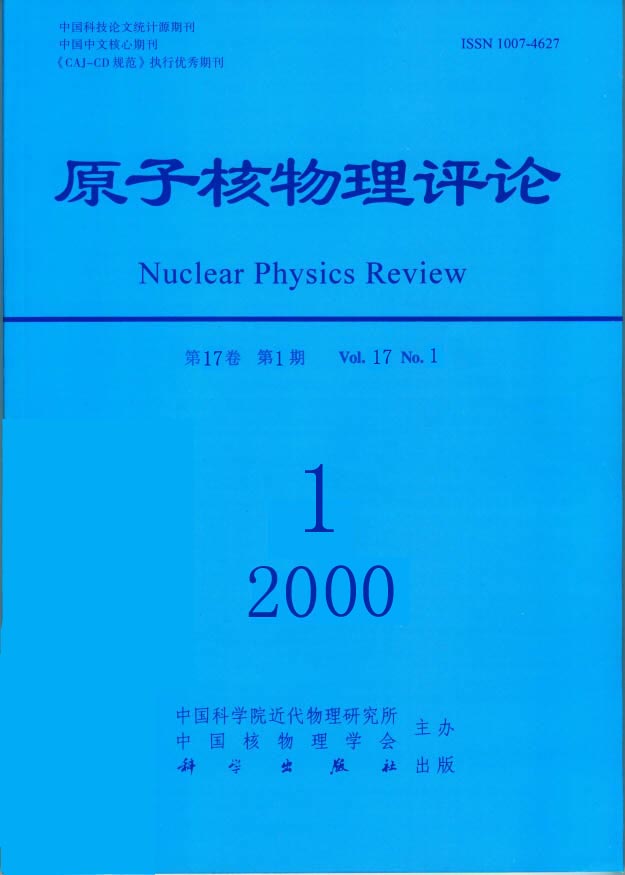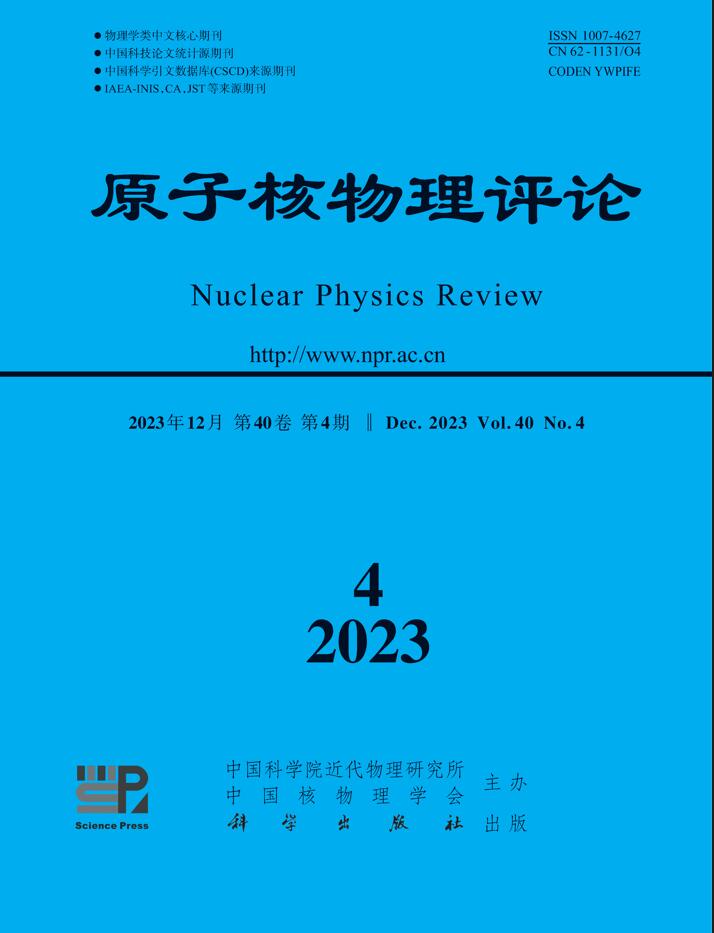2000 Vol. 17, No. 1

Display Method:
2000, 17(1): 1-5.
doi: 10.11804/NuclPhysRev.17.01.001
Abstract:
Systematic summary on the anomalous anisotropies of fission fragments in near and sub barrier fusion fission reactions is presented. A new version of the preequilibrium fission model is put forward to explain the anomalous anisotropies of fission fragments, except the bump of anomaly. Further study is still needed.
Systematic summary on the anomalous anisotropies of fission fragments in near and sub barrier fusion fission reactions is presented. A new version of the preequilibrium fission model is put forward to explain the anomalous anisotropies of fission fragments, except the bump of anomaly. Further study is still needed.
2000, 17(1): 6-9.
doi: 10.11804/NuclPhysRev.17.01.006
Abstract:
An analysis is made for the (0s) 6 six quark cluster states in the chiral SU (3) quark model. The results show that for some multistrangeness states the chiral SU (3) could offer more attraction. Further RGM dynamical calculation of the multistrangeness system (ΩΩ) 0+ and (ΩΞ) 1+ has been done. It shows that (ΩΩ) 0+ is a deeply bound state in the chiral SU (3) quark model.
An analysis is made for the (0s) 6 six quark cluster states in the chiral SU (3) quark model. The results show that for some multistrangeness states the chiral SU (3) could offer more attraction. Further RGM dynamical calculation of the multistrangeness system (ΩΩ) 0+ and (ΩΞ) 1+ has been done. It shows that (ΩΩ) 0+ is a deeply bound state in the chiral SU (3) quark model.
2000, 17(1): 10-18.
doi: 10.11804/NuclPhysRev.17.01.010
Abstract:
A simple introduction of the discovery of quark and the constituent quark model of nucleon have been given. The contradiction between the quark spin structure of nucleon of the constituent quark model and the measured one in the polarized deep inelastic lepton nucleon scattering has been explained in detail. It is elucidated that the so called “proton spin crisis” is due to quark spin confusion. The incompatibility between the requirement of gauge invariance and ...
A simple introduction of the discovery of quark and the constituent quark model of nucleon have been given. The contradiction between the quark spin structure of nucleon of the constituent quark model and the measured one in the polarized deep inelastic lepton nucleon scattering has been explained in detail. It is elucidated that the so called “proton spin crisis” is due to quark spin confusion. The incompatibility between the requirement of gauge invariance and ...
2000, 17(1): 19-21.
doi: 10.11804/NuclPhysRev.17.01.019
Abstract:
Different opinions about prospects of the development of nuclear physics in the 21st century are displayed, and indicating great opportunities and challenges faced by nuclear physicists in the future are analyzed in detail.
Different opinions about prospects of the development of nuclear physics in the 21st century are displayed, and indicating great opportunities and challenges faced by nuclear physicists in the future are analyzed in detail.
2000, 17(1): 22-29.
doi: 10.11804/NuclPhysRev.17.01.022
Abstract:
The nucleon (hadron) is the bound state of guarks and gluons, which is described by the quantum chromodynamics (QCD). Due to the basic properties of QCD (the asymptotic freedom at the high energy scale, the color confinement and the dynamical chiral symmetry breaking at the low energy scale), the QCD picture for the nucleon’s (hadron’s) structure and property is scale dependent. At high energy scale, the QCD parton model, which is relative to the hard process for testing the...
The nucleon (hadron) is the bound state of guarks and gluons, which is described by the quantum chromodynamics (QCD). Due to the basic properties of QCD (the asymptotic freedom at the high energy scale, the color confinement and the dynamical chiral symmetry breaking at the low energy scale), the QCD picture for the nucleon’s (hadron’s) structure and property is scale dependent. At high energy scale, the QCD parton model, which is relative to the hard process for testing the...
2000, 17(1): 30-34.
doi: 10.11804/NuclPhysRev.17.01.030
Abstract:
By a generalized version of AGS reduction procedure we show that the forms of quantum dynamics at different strata are the same. This is the self similarity of quantum dynamics.
By a generalized version of AGS reduction procedure we show that the forms of quantum dynamics at different strata are the same. This is the self similarity of quantum dynamics.
2000, 17(1): 35-38.
doi: 10.11804/NuclPhysRev.17.01.035
Abstract:
It is shown that for a particle with suitable angular momenta in the screened Coulomb potential or isotropic harmonic potential, there still exists closed orbits rather than ellipse, characterized by the conserved perihelion and aphelion vectors, i.e., extended Runge Lenz vector, which implies a higher dynamical symmetry than the geometrical symmetry SO 3. For the potential, factorization of the radial Schrdinger equation to produce raising and lowering operators is also pointed out.
It is shown that for a particle with suitable angular momenta in the screened Coulomb potential or isotropic harmonic potential, there still exists closed orbits rather than ellipse, characterized by the conserved perihelion and aphelion vectors, i.e., extended Runge Lenz vector, which implies a higher dynamical symmetry than the geometrical symmetry SO 3. For the potential, factorization of the radial Schrdinger equation to produce raising and lowering operators is also pointed out.
2000, 17(1): 39-42.
doi: 10.11804/NuclPhysRev.17.01.039
Abstract:
Based on Fermi Yang Liming method and its improved method, magic numbers were calculated by using Woods Saxon density function. That the magic number next to 126 should be 184 was predicted.
Based on Fermi Yang Liming method and its improved method, magic numbers were calculated by using Woods Saxon density function. That the magic number next to 126 should be 184 was predicted.
2000, 17(1): 43-50.
doi: 10.11804/NuclPhysRev.17.01.043
Abstract:
Listing more than one hundred unanswered questions the present author claims that 1) the long standing puzzles in physics may be the signals of new physics; 2) the effort of searching for the basic natural laws of physics is always highly worthwhile.
Listing more than one hundred unanswered questions the present author claims that 1) the long standing puzzles in physics may be the signals of new physics; 2) the effort of searching for the basic natural laws of physics is always highly worthwhile.
2000, 17(1): 51-55.
doi: 10.11804/NuclPhysRev.17.01.051
Abstract:
The pomeron in high energy hadron hadron scattering as well as the QCD nature of the pomeron are discussed. We claimed that the pomeron may be the tenser glueball ξ(2 230) with quantum number I G =0 +, J PC =2 ++ . Under this reggeized glueball model the cross section of high energy proton proton scattering and the coupling parameter of the pomeron nucleon, β , are calculated. The theoretical results of the present model are in good agreement with experimental data.
The pomeron in high energy hadron hadron scattering as well as the QCD nature of the pomeron are discussed. We claimed that the pomeron may be the tenser glueball ξ(2 230) with quantum number I G =0 +, J PC =2 ++ . Under this reggeized glueball model the cross section of high energy proton proton scattering and the coupling parameter of the pomeron nucleon, β , are calculated. The theoretical results of the present model are in good agreement with experimental data.
2000, 17(1): 56-57.
doi: 10.11804/NuclPhysRev.17.01.056
Abstract:
Correlated fission fragments from the 40Ar+209Bi reaction and their further correlation with α particles have been studied for peripheral and central collisions simultaneously. The existence of different fission behavior of hot nuclei formed in central and peripheral collisions was found from the systematic analysis of the mass and energy distributions of fission fragments as a function of the initial temperature of hot fissioning nuclei.
Correlated fission fragments from the 40Ar+209Bi reaction and their further correlation with α particles have been studied for peripheral and central collisions simultaneously. The existence of different fission behavior of hot nuclei formed in central and peripheral collisions was found from the systematic analysis of the mass and energy distributions of fission fragments as a function of the initial temperature of hot fissioning nuclei.
2000, 17(1): 58-62.
doi: 10.11804/NuclPhysRev.17.01.058
Abstract:
Electron cyclotron resonance (ECR) ion source is the most efficient facility for producing highly charged ions. So far more than 1 emA of O 6+ and 0.02 eμA of U 55+ have been delivered by ECR ion source. In this paper the latest development of ECR ion source is presented and several typical ECR ion sources in the world is introduced.
Electron cyclotron resonance (ECR) ion source is the most efficient facility for producing highly charged ions. So far more than 1 emA of O 6+ and 0.02 eμA of U 55+ have been delivered by ECR ion source. In this paper the latest development of ECR ion source is presented and several typical ECR ion sources in the world is introduced.







 甘公网安备 62010202000723号
甘公网安备 62010202000723号